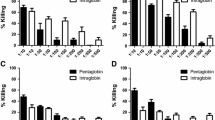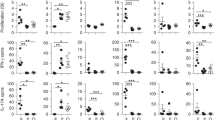Abstract
By fusing a human hybridoma producing an IgG2ķ antibody against human A431 epidermoid carcinoma cells with an Epstein-Barr virus-transformed human B lymphocyte producing an IgG2ķ antibody against Pseudomonas aeruginosa exotoxin A, we established a hybrid hybridoma producing a bispecific monoclonal antibody reacting with both A431 cells and the exotoxin. Human IgG was purified from the culture supernatant of the hybrid hybridoma, and the bispecific monoclonal antibody in the IgG preparation was further separated from the two parental antibodies by hydroxyapatite high-performance liquid chromatography. The human bispecific monoclonal antibody thus obtained efficiently targeted the antibody-reative cells, A431, for attack by the exotoxin in vitro.
Similar content being viewed by others
Abbreviations
- bs mAb:
-
Bispecific Monoclonal Antibody
- HRP:
-
Horseradish Peroxidase
- MHA:
-
Mixed Hemadsorption Assay
- MTT:
-
3-(4,5-Dimethylthiazol-2-yl)-2,5-diphenyltetrazolium Bromide
- PEA:
-
Pseudomonas aeruginosa Exotoxin A
- PEG:
-
Polyethylene Glycol
References
Corvalan JRF, Smith W, Gore VA and Brandon DR (1987) Specific in vitro and in vivo drug localisation to tumor cells using a hybrid-hybrid monoclonal antibody recognising both carcinoembryonic antigen (CEA) and vinca alkaloids. Cancer Immunol. Immunother. 24: 133–137.
Corvalan JRF, Smith W and Gore VA (1988) Tumour therapy with vinca alkaloids targeted by a hybrid-hybrid monoclonal antibody recognising both CEA and vinca alkaloids. Int. J. Cancer Supplement 2: 22–25.
Glennie MJ, McBride HM, Worth AT and Stevenson GT (1987) Preparation and performance of bispecific F(ab'γ)2 antibody containing thioether-linked Fab'γ fragments. J. Immunol. 139: 2367–2375.
Hämmerling U, Aoki T, Harven E, Boyse EA and Old LJ (1968) Use of hybrid antibody with anti-γG and anti-ferritin specificities in locating cell surface antigens by electron microscopy. J. Exp. Med. 128: 1461–1469.
Ichimori Y, Harada K, Hitotsumachi S and Tsukamoto K (1987) Establishment of hybridoma secreting human monoclonal antibody against hepatitis B virus surface antigen. Biochem. Biophys. Res. Commun. 142: 805–812.
Iglewski BH and Kabat D (1975) NAD-dependent inhibition of protein synthesis by Pseudomonas aeruginosa toxin. Proc. Natl. Acad. Sci. USA 72: 2284–2288.
Kitano K, Shintani Y, Ichimori Y, Tsukamoto K, Sasai S and Kida M (1986) Production of human monoclonal antibodies by heterohybridomas. Appl. Microbiol. Biotechnol. 24: 282–286.
Kuriyama M, Ichimori Y, Iwasa S and Tsukamoto K (1990) A human-human hybridoma secreting anti-Pseudomonas aeruginosa exotoxin A monoclonal antibody with highly potent neutralizing activity. Cytotechnology 3: 31–37.
Laemmli UK (1970) Cleavage of structural proteins during the assembly of the head of bacteriophage T4. Nature 227: 680–685.
Lanzavecchia A and Scheidegger D (1987) The use of hybrid hybridomas to target human cytotoxic T lymphocytes. Eur. J. Immunol. 17: 105–111.
Milstein C and Cuello AC (1983) Hybrid hybridomas and their use in immunohistochemistry. Nature 305: 537–540.
Milstein C and Cuello AC (1984) Hybrid hybridomas and the production of bi-specific monoclonal antibodies. Immunol. Today 5: 299–304.
Nisonoff A and Rivers MM (1961) Recombination of a mixture of univalent antibody fragments of different specificity. Arch. Biochem. Biophys. 90: 460–462.
Pastan I and FitzGerald D (1989) Pseudomonas exotoxin: chimeric toxins. J. Biol. Chem. 264: 15157–15160.
Pirker R, FitzGerald DJP, Hamilton TC, Ozols RF, Willingham MC and Pastan I (1985) Anti-transferrin receptor antibody linked to Pseudomonas exotoxin as a model immunotoxin in human ovarian carcinoma cell line. Cancer Res. 45: 751–757.
Staerz UD and Bevan MJ (1986) Hybrid hybridoma producing a bispecific monoclonal antibody that can focus effector T-cell activity. Proc. Natl. Acad. Sci. USA 83: 1453–1457.
Suresh MR, Cuello AC and Milstein C (1986) Bispecific monoclonal antibodies from hybrid hybridomas. Methods Enzymol. 121: 210–228.
Tada H, Shiho O, Kuroshima K, Koyama M and Tsukamoto K (1986) An improved colorimetric assay for interleukin 2. J. Immunol. Methods 93: 157–165.
Tada H, Toyoda Y and Iwasa S (1989) Bispecific antibody-producing hybrid hybridoma and its use in one-step immunoassays for human lymphotoxin. Hybridoma 8: 73–83.
Tiebout RF, Boxtel-Oosterhof F, Stricker EAM and Zeijlemaker WP (1987) A human hybrid hybridoma. J. Immunol. 139: 3402–3405.
Webb KS, Ware JL, Parks SF, Walther PJ and Paulson DF (1985) Evidence for a novel hybrid immunotoxin recognizing ricin A-chain by one antigen-combining site and a prostate-restricted antigen by the remaining antigen-combining site: potential for immunotherapy. Cancer Treat. Rep. 69: 663–672.
Willingham MC, FitzGerald DJ and Pastan I (1987) Pseudomonas exotoxin coupled to a monoclonal antibody against ovarian cancer inhibits the growth of human ovarian cancer cells in a mouse model. Proc. Natl. Acad. Sci. USA 84: 2474–2478.
Author information
Authors and Affiliations
Rights and permissions
About this article
Cite this article
Honda, S., Ichimori, Y. & Iwasa, S. A hyman hybrid hybridoma producing a bispecific monoclonal antibody that can target tumor cells for attack by Pseudomonas aeruginosa exotoxin A. Cytotechnology 4, 59–68 (1990). https://doi.org/10.1007/BF00148811
Received:
Accepted:
Issue Date:
DOI: https://doi.org/10.1007/BF00148811




